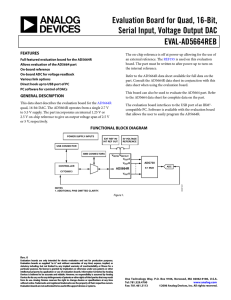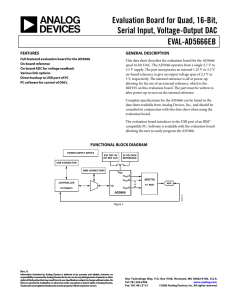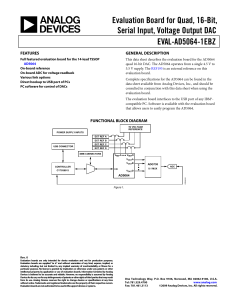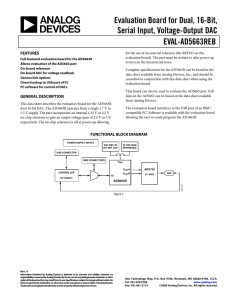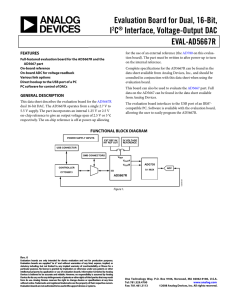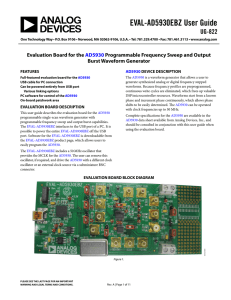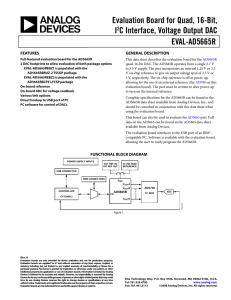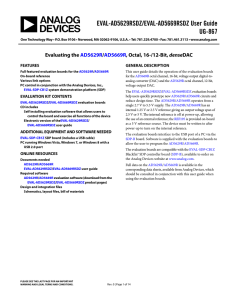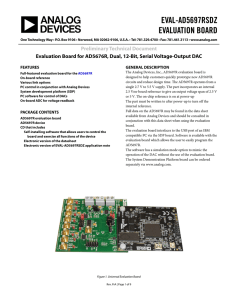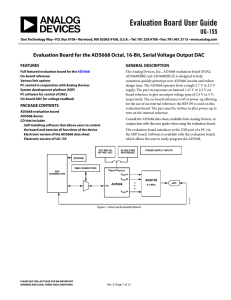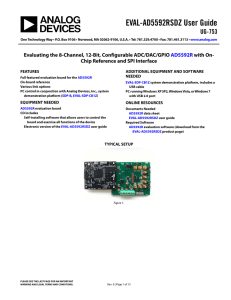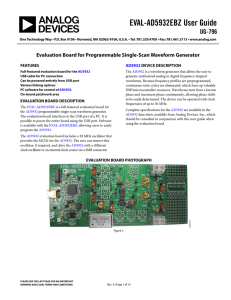Evaluation Board User Guide UG-144
advertisement
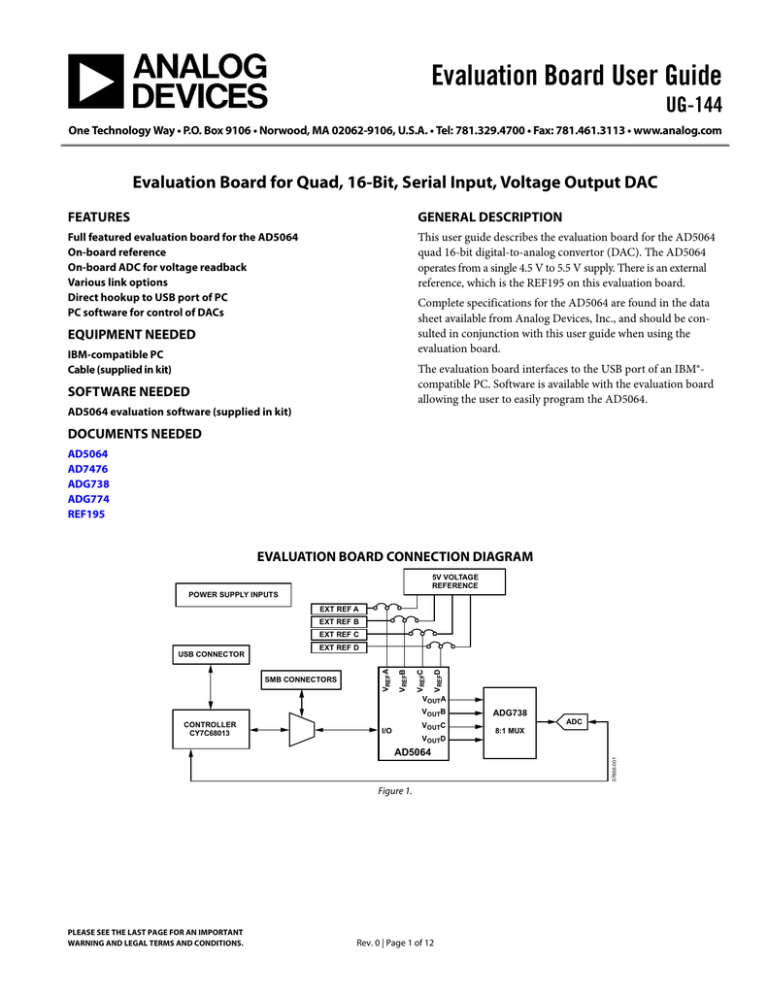
Evaluation Board User Guide UG-144 One Technology Way • P.O. Box 9106 • Norwood, MA 02062-9106, U.S.A. • Tel: 781.329.4700 • Fax: 781.461.3113 • www.analog.com Evaluation Board for Quad, 16-Bit, Serial Input, Voltage Output DAC FEATURES GENERAL DESCRIPTION Full featured evaluation board for the AD5064 On-board reference On-board ADC for voltage readback Various link options Direct hookup to USB port of PC PC software for control of DACs This user guide describes the evaluation board for the AD5064 quad 16-bit digital-to-analog convertor (DAC). The AD5064 operates from a single 4.5 V to 5.5 V supply. There is an external reference, which is the REF195 on this evaluation board. Complete specifications for the AD5064 are found in the data sheet available from Analog Devices, Inc., and should be consulted in conjunction with this user guide when using the evaluation board. EQUIPMENT NEEDED IBM-compatible PC Cable (supplied in kit) The evaluation board interfaces to the USB port of an IBM®compatible PC. Software is available with the evaluation board allowing the user to easily program the AD5064. SOFTWARE NEEDED AD5064 evaluation software (supplied in kit) DOCUMENTS NEEDED AD5064 AD7476 ADG738 ADG774 REF195 EVALUATION BOARD CONNECTION DIAGRAM 5V VOLTAGE REFERENCE POWER SUPPLY INPUTS EXT REF A EXT REF B EXT REF C VREF D VREF C SMB CONNECTORS VREF A EXT REF D VREF B USB CONNECTOR VOUTA VOUTB VOUTC I/O ADC 8:1 MUX VOUTD AD5064 Figure 1. PLEASE SEE THE LAST PAGE FOR AN IMPORTANT WARNING AND LEGAL TERMS AND CONDITIONS. ADG738 Rev. 0 | Page 1 of 12 07866-001 CONTROLLER CY7C68013 UG-144 Evaluation Board User Guide TABLE OF CONTENTS Features .............................................................................................. 1 Link Options ..................................................................................3 Equipment Needed ........................................................................... 1 Evaluation Board Software ...............................................................4 Software Needed ............................................................................... 1 Installing the Software ..................................................................4 Documents Needed .......................................................................... 1 Software Operation .......................................................................4 General Description ......................................................................... 1 Evaluation Board Schematics and Artwork ...................................5 Evaluation Board Connection Diagram ........................................ 1 Ordering Information .......................................................................9 Revision History ............................................................................... 2 Bill of Materials ..............................................................................9 Evaluation Board Hardware ............................................................ 3 Related Links ......................................................................................9 Power Supplies .............................................................................. 3 REVISION HISTORY 6/10—Revision 0: Initial Version Rev. 0 | Page 2 of 12 Evaluation Board User Guide UG-144 EVALUATION BOARD HARDWARE POWER SUPPLIES LINK OPTIONS To power the EVAL-AD5064EBZ, supply 5.5 V between the AVDD and AGND inputs for the analog supply of the AD5064. Alternatively, placing Link 6 in Position B powers the analog circuitry from the USB port (default setting). A number of link and switch options on the evaluation board should be set for the required operating setup before using the board. The functions of these link options are described in detail in Table 2. The default setup is for control by the PC via the USB port. The default link options are listed in Table 1. Both AGND and DGND inputs are provided on the board. The AGND and DGND planes are connected at one location close to the AD5064. To avoid ground loop problems, do not connect AGND and DGND elsewhere in the system. Each supply is decoupled to the relevant ground plane with 10 μF and 0.1 μF capacitors. Each device supply pin is also decoupled with a 10 μF and 0.1 μF capacitor pair to the relevant ground plane. Table 1. Link Options Setup for PC Control (Default) Link No. LK1 to LK4 LK5 LK6 LK7 LK8 LK9 LK10 LK11 LK12 LK13 to LK16 Option Inserted B B A A B A A A B Table 2. Link Functions Link No. LK1 to LK4 LK5 LK6 LK7 LK8 LK9 LK10 LK11 LK12 LK13 to LK16 Function These links connect the VOUTA to VOUTD pins of the AD5064 to the input/output pins of the ADG738 demultiplexer to monitor the DAC output value using the on-board AD7476 ADC. This link selects the AVDD power supply source for the analog circuitry. Position A selects J6 as the AVDD analog circuitry power supply source. Position B selects the 5 V power supply source as the AVDD analog circuitry power supply source (see LK6). This link selects the 5 V power supply source for the digital circuitry. Position A selects J7 as the 5 V digital circuitry power supply source. Position B selects the USB port as the 5 V digital circuitry power supply. This link selects whether the AD5064 evaluation board is controlled by the PC via the USB port or by an external source via the SMB connectors (J1 to J5). Position A selects control by the PC via the USB port. Position B selects control by an external source via the SMB connectors (J1 to J5). This link sets the RESET pin on the ADG738. Position A allows normal operation of the switch. Position B resets the switch. This link selects the AVDD power supply source for the REF195. Position A selects J6 as the REF195 power supply source. Position B selects the AVDD as the REF195 power supply source (see LK5). This link selects the DAC power supply source. Position A selects the AVDD as the DAC power supply source. Position B selects an external source via SMB Connector EXT_VDD as the power supply source. This link selects the DAC voltage source. Position A selects the DAC power supply source as the DAC voltage source (see LK10). Position B selects the on-board REF195 5 V reference as the DAC voltage source. This link selects whether the part power-on resets to zero or midscale. Position A ensures that the POR of the part resets to midscale. Position B ensures that the POR of the part resets to zero scale. These links select the reference sources for VREFA to VREFD. Position A selects an external reference via the SMB connectors (EXT_REF_A, EXT_REF_B, EXT_REF_C, and EXT_REF_D). Position B selects the on-board REF195 5 V reference as the reference source. Rev. 0 | Page 3 of 12 UG-144 Evaluation Board User Guide EVALUATION BOARD SOFTWARE INSTALLING THE SOFTWARE Command Bits The AD5064 evaluation kit includes self-installing software on CD. The software is compatible with Microsoft® Windows® 2000 and Windows XP. 1. To ensure that the board is correctly recognized when connected to the PC, install the software before connecting the evaluation board to the USB port of the PC. To select a command to program the part, click the dropdown menu button under the Select Control Function section and select the appropriate option from the menu. For example, to program all DAC outputs with full scale, click Write to and Update DAC Channel n. 2. Click All DACs in the Address Bits section. 1. Start the Windows operating system and insert the CD. 3. In the Data section, enter the data in hexadecimal value. 2. The installation software should launch automatically. If it does not, run the setup.exe file directly from the CD. 4. To execute, click Write to Part. You must click Write to Part to execute all writes to the part. 3. After installation from the CD is complete, power up the AD5064 evaluation board as described in the Power Supplies section. Connect the evaluation board to the USB port of the PC using the cable that is supplied. 4. When the software detects the evaluation board, proceed through any dialog boxes that appear until the installation is completed. Other commands that the AD5064 evaluation software allows you to program include the power-down DAC bits, the clear code register bits, and the register bits by clicking the corresponding option button under the Select Control Function section and then clicking Write to Part. You can also set the register bits for the required mode of operation. Consult the AD5064 data sheet for details. Hardware Pins SOFTWARE OPERATION 1. From the Analog Devices menu, click Start > All Programs > Analog Devices > AD5064 > AD5064 Evaluation Software. For older PCs, click Start > Programs > Analog Devices > AD5064 > AD5064 Evaluation Software. ADC The voltage output on each DAC channel is monitored using the on-board ADC. To read the output voltage, click the OK button under the Sample ADC section and select which channel to read (A, B, C, or D) under the ADC section. 07866-002 The main window of the AD5064 evaluation software opens, as shown in Figure 2. The data programmed into the 32-bit input shift register is displayed. You can select the command bits, the address bits, and the data bits by clicking the appropriate option button under each section. To set LDAC and CLR high or low, click the corresponding checkbox, LDAC or CLR, located on the right portion of the screen dedicated to the hardware pins. This command executes immediately; therefore, there is no need to click Write to Part. Figure 2. AD5064 Evaluation Software Main Window Rev. 0 | Page 4 of 12 Evaluation Board User Guide UG-144 EVALUATION BOARD SCHEMATICS AND ARTWORK 07866-003 Figure 3. Schematic of Controller Circuitry Rev. 0 | Page 5 of 12 UG-144 Evaluation Board User Guide VOUTD VOUTC VOUTB VOUTA 07866-004 VREFD U1 VREFC VREFB VREFA VDD Figure 4. Schematic of AD5064 Circuitry Rev. 0 | Page 6 of 12 UG-144 07866-005 Evaluation Board User Guide 07866-006 Figure 5. Component Placement Drawing Figure 6. Component Side PCB Drawing Rev. 0 | Page 7 of 12 Evaluation Board User Guide 07866-007 UG-144 Figure 7. Solder Side PCB Drawing Rev. 0 | Page 8 of 12 Evaluation Board User Guide UG-144 ORDERING INFORMATION BILL OF MATERIALS Table 3. Quantity 1 1 1 2 1 1 1 1 1 9 1 1 1 1 5 2 22 1 1 4 1 4 1 2 2 1 1 5 8 21 Reference Designator U7 U1 U9 U2, U3 U5 U6 U4 U8 Y1 VOUTA to VOUTD; J1 to J5 J10 J6 J7 D1 C4, C5, C11, C18, C35 C26, C27 C1 to C3, C6 to C8, C12, C17, C19 to C23, C25, C28 to C34, C36 C24 C10 C13 to C16 R1 R2 to R5 R6 R7, R8 R11, R12 R10 R9 LK1 to LK4, LK10 LK5 to LK9, LK11 to LK13 T1 to T21 Description ADP3303AR-3 AD5064BRUZ-2 (3) 24LC01 ADG774BRQ AD7476ART ADG738BRU REF195ES CY7C68013-CSP 24 MHz crystal Gold 50 Ω SMB jack USB Mini B Power connectors Power connectors LED 10 μF 10 V tantalum capacitor (TAJ-B package) 22 pF (0603 package) 0.1 μF (0603 package) Supplier/Number Analog Devices Analog Devices FEC 9758070 Analog Devices Analog Devices Analog Devices Analog Devices Embassy CY7C68013-56LFC FEC 569-872 FEC 365 1228 FEC 476-8309 FEC 151-786 FEC 151-785 FEC 359-9681 FEC 197-130 FEC 722-005 FEC 882-0023 2.2 μF (0603 package) 1 μF (0603 package) 0805 package (not inserted) 1.5 Ω Wire wrap pin (not inserted) 1 kΩ (0603 package) 100 kΩ (0603 package) 2.2 kΩ (0603 package) 10 kΩ (0603 package) 0 Ω (0603 package) Header (2 × 1 pin) Header (3 × 1 pin) Testpoint Digikey 490-1552-1-ND FEC 318-8840 FEC 758-267 FEC 911-239 FEC 911 471 FEC 911-276 FEC 911-355 FEC 772-227 FEC 511-705 FEC 511-717 FEC 873-1144 RELATED LINKS Resource AD5064 AD7476 ADG738 ADG774 ADP3303 REF195 Description Product page, AD5064 Fully Accurate 16-Bit VOUT nanoDAC™ Quad, SPI Interface, 4.5 V to 5.5 V in TSSOP Product page, AD7476 1 MSPS, 12-Bit ADC in 6-Lead SOT-23 Product page, ADG738 CMOS, Low Voltage, Single 8-to-1 Multiplexer, Serially Controlled Matrix Switch Product page, ADG774 2.2 Ω, Wide Bandwidth, Low Voltage Quad SPDT Switch Product page, ADP3303 High Accuracy anyCAP® 200 mA Low Dropout Linear Regulator Product page, REF195 Precision Micropower, Low Dropout, Low Voltage Reference Rev. 0 | Page 9 of 12 UG-144 Evaluation Board User Guide NOTES Rev. 0 | Page 10 of 12 Evaluation Board User Guide UG-144 NOTES Rev. 0 | Page 11 of 12 UG-144 Evaluation Board User Guide NOTES ESD Caution ESD (electrostatic discharge) sensitive device. Charged devices and circuit boards can discharge without detection. Although this product features patented or proprietary protection circuitry, damage may occur on devices subjected to high energy ESD. Therefore, proper ESD precautions should be taken to avoid performance degradation or loss of functionality. Legal Terms and Conditions By using the evaluation board discussed herein (together with any tools, components documentation or support materials, the “Evaluation Board”), you are agreeing to be bound by the terms and conditions set forth below (“Agreement”) unless you have purchased the Evaluation Board, in which case the Analog Devices Standard Terms and Conditions of Sale shall govern. Do not use the Evaluation Board until you have read and agreed to the Agreement. Your use of the Evaluation Board shall signify your acceptance of the Agreement. This Agreement is made by and between you (“Customer”) and Analog Devices, Inc. (“ADI”), with its principal place of business at One Technology Way, Norwood, MA 02062, USA. Subject to the terms and conditions of the Agreement, ADI hereby grants to Customer a free, limited, personal, temporary, non-exclusive, non-sublicensable, non-transferable license to use the Evaluation Board FOR EVALUATION PURPOSES ONLY. Customer understands and agrees that the Evaluation Board is provided for the sole and exclusive purpose referenced above, and agrees not to use the Evaluation Board for any other purpose. Furthermore, the license granted is expressly made subject to the following additional limitations: Customer shall not (i) rent, lease, display, sell, transfer, assign, sublicense, or distribute the Evaluation Board; and (ii) permit any Third Party to access the Evaluation Board. As used herein, the term “Third Party” includes any entity other than ADI, Customer, their employees, affiliates and in-house consultants. The Evaluation Board is NOT sold to Customer; all rights not expressly granted herein, including ownership of the Evaluation Board, are reserved by ADI. CONFIDENTIALITY. This Agreement and the Evaluation Board shall all be considered the confidential and proprietary information of ADI. Customer may not disclose or transfer any portion of the Evaluation Board to any other party for any reason. Upon discontinuation of use of the Evaluation Board or termination of this Agreement, Customer agrees to promptly return the Evaluation Board to ADI. ADDITIONAL RESTRICTIONS. Customer may not disassemble, decompile or reverse engineer chips on the Evaluation Board. Customer shall inform ADI of any occurred damages or any modifications or alterations it makes to the Evaluation Board, including but not limited to soldering or any other activity that affects the material content of the Evaluation Board. Modifications to the Evaluation Board must comply with applicable law, including but not limited to the RoHS Directive. TERMINATION. ADI may terminate this Agreement at any time upon giving written notice to Customer. Customer agrees to return to ADI the Evaluation Board at that time. LIMITATION OF LIABILITY. THE EVALUATION BOARD PROVIDED HEREUNDER IS PROVIDED “AS IS” AND ADI MAKES NO WARRANTIES OR REPRESENTATIONS OF ANY KIND WITH RESPECT TO IT. ADI SPECIFICALLY DISCLAIMS ANY REPRESENTATIONS, ENDORSEMENTS, GUARANTEES, OR WARRANTIES, EXPRESS OR IMPLIED, RELATED TO THE EVALUATION BOARD INCLUDING, BUT NOT LIMITED TO, THE IMPLIED WARRANTY OF MERCHANTABILITY, TITLE, FITNESS FOR A PARTICULAR PURPOSE OR NONINFRINGEMENT OF INTELLECTUAL PROPERTY RIGHTS. IN NO EVENT WILL ADI AND ITS LICENSORS BE LIABLE FOR ANY INCIDENTAL, SPECIAL, INDIRECT, OR CONSEQUENTIAL DAMAGES RESULTING FROM CUSTOMER’S POSSESSION OR USE OF THE EVALUATION BOARD, INCLUDING BUT NOT LIMITED TO LOST PROFITS, DELAY COSTS, LABOR COSTS OR LOSS OF GOODWILL. ADI’S TOTAL LIABILITY FROM ANY AND ALL CAUSES SHALL BE LIMITED TO THE AMOUNT OF ONE HUNDRED US DOLLARS ($100.00). EXPORT. Customer agrees that it will not directly or indirectly export the Evaluation Board to another country, and that it will comply with all applicable United States federal laws and regulations relating to exports. GOVERNING LAW. This Agreement shall be governed by and construed in accordance with the substantive laws of the Commonwealth of Massachusetts (excluding conflict of law rules). Any legal action regarding this Agreement will be heard in the state or federal courts having jurisdiction in Suffolk County, Massachusetts, and Customer hereby submits to the personal jurisdiction and venue of such courts. The United Nations Convention on Contracts for the International Sale of Goods shall not apply to this Agreement and is expressly disclaimed. ©2010 Analog Devices, Inc. All rights reserved. Trademarks and registered trademarks are the property of their respective owners. UG07866-0-6/10(0) Rev. 0 | Page 12 of 12
